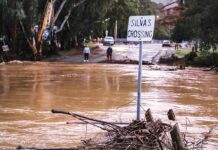Columnist Martin Cheek made some valuable observations in his
recent column on dam safety.
Dear Editor,
Columnist Martin Cheek made some valuable observations in his recent column on dam safety. Though our local dams are very different than St. Francis Dam which failed in 1928, what we have learned from such tragedies helps us avoid similar catastrophic dam failures in the future. Public safety is the Santa Clara Valley Water District’s top concern. The district is using 80 years of engineering and seismic learning to evaluate the dams built to the standard of the time to ensure the public’s safety and a reliable supply of water.
Dozens of California dams have seismic stability concerns, and many of them will need to be retrofitted. Addressing the seismic issues at Anderson Dam is a high priority for the state Division of Safety of Dams, precisely because of the large population that lives below the dam.
Our understanding of dam safety and earthquake faults in our region has advanced significantly since Anderson Dam was built in the 1950s. The engineering world has learned a lot from dam failures, and we now know more about the various earthquake faults that crisscross our region. As a result, we have a better understanding of our dams’ potential vulnerabilities, and now have the opportunity to assure that they comply with modern dam safety standards.
A dam failure could be catastrophic. That’s why the water district is keeping the water storage at Anderson Dam at a safe level. We are wasting no time in initiating the process to plan, design and build a retrofit project that will protect the public, and preserve our ability to use the full capacity of the reservoir for our water supply. An accurate estimate of costs to retrofit the dam won’t be available until a comprehensive solution is developed and the project has finished the planning phase.
Regarding the St. Francis Dam tragedy, our situation is different at Anderson Dam. Anderson is an earthen dam built from clay, soil and rock, while the St. Francis Dam was a concrete gravity-arch dam. Earthen dams do not break like St. Francis Dam did; they slump. Anderson Dam is a much more malleable earth embankment that met the standards for design and construction at the time it was built.
The study we recently completed concluded that the dam could be damaged, causing slumping of up to 25 feet if the maximum credible earthquake were to occur. Only if the water level were 20 feet higher than the current storage restriction of 68 percent would there be a possibility that water could wash over the dam crest. Yes, that scenario would be catastrophic, but that is why the water level will be restricted until the dam is retrofitted.
As Mr. Cheek noted, the Division of Safety of Dams was created as a result of the St. Francis catastrophe. We are working closely with DSOD to minimize the chance of any dam failure.
In the next three years, we will continue the process of developing the best comprehensive solution to the problem, conduct the required environmental analysis and secure all project permits.
Throughout the process, we want you to be informed and involved. We will actively and regularly communicate with the community.
Don Gage, Gilroy,
Santa Clara Valley Water District Board Chairman












